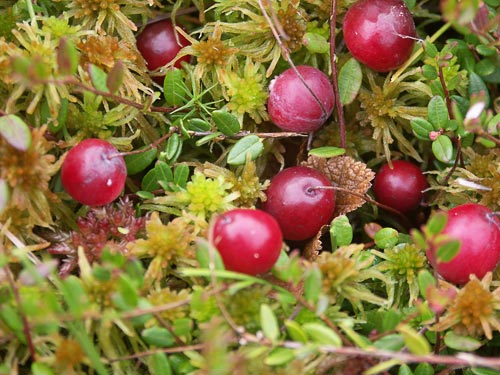Relatives
Oxycoccus palustris Pers. - Cranberry marsh.
Taxonomic position.
Family Ericaceae Juss. (Synonym: Vacciniaceae S.F. Gray), genus Oxycoccus Hill.)Basic synonyms.
O. qudripetalus Gilib.; Vaccinium oxycoccos L.)Morphology and biology.
Perennial plant; evergreen prostrate under-shrub with thin offshoots up to 75 cm long. Leaves are leathery, ovate or oblong-ovate, 8-16 mm long and 3-6 mm wide, sharp at the ends, brilliant and dark green from above, bluish grey from below because of a waxy coating. Petioles are short, up to 1 mm long. Edges of leaves are curled. Flowers are collected into umbellate inflorescences, 2-4 (6) on the ends of last year's branches. Peduncles are mono-floral, hung and covered by short hairs, 15-45 mm long, protruding from scale-like leaflets. Calyx is quadrifid; calyx lobes are spherical, 0.5 mm long and 1 mm wide, ciliated-pubescent on edges. The nimbus is separated into four sections; petals are rose-red, upwardly bent, 4-7 mm long. There are 8 stamens, whose strings are densely pubescent along the edges; anthers are warty. The column is higher than the stamens and the nimbus. The berry is dark red, juicy, sour, has spherical or oblong-ovate form. Blossoms in May-July; produces fruit in August-September. Entomophilous. Zoochore. 2n=48.Distribution.
The general distribution area includes Scandinavia, Central and Atlantic Europe, northern China, northern Japan, and North America. Within the former USSR, the species occurs in the European part (all areas to the north from middle Dnepr, the upper Dnestr and middle Volga), all areas of Western and Eastern Siberia, and the Far East (Kamchatka, Sakhalin).Ecology.
Grows in sphagnum moss bogs.Use and economic value.
Berries are widely used in the food-processing industry for the manufacturing of jam and pickling of cabbage; also used in confectionery and liqueur manufacturing. Berries contain (10 mg) vitamin C, citric acid and three kinds of sugars -- glucose, fructose and saccharose; saccharose makes up a small percentage (0.22%).Reference citations:
Cherepanov S.K. 1995. Plantae Vasculares Rossicae et Civitatum Collimitanearum (in limics USSR olim) [List of Vascular Plants of Russia]. St. Petersburg: Mir I Semia. 990 pp. (In Russian)Cherkasov A.F., Butcus B.F., Gorbunov A.V. 1981. Cranberry. Moscow. 213 p.
Kharkevich, S.S., ed. 1991. Flora of the Soviet Far East. Vol. 5: 154-156.
Kharkevich S.S., ed. 1996. Vascular plants of the Soviet Far East. Vol. 8. Leningrad: Nauka. 382 p. (In Russian)
Koropachinskiy I.Yu., Vstovskaya T.N. 2002. Woody plants of the Asian part of Russia. Novosibirsk: Publishing House of SB RAS, Branch "Geo". 707 p. (In Russian)
Malyshev L.I., Peshkova G.A., eds. 1997. Flora of the Central Siberia. Vol. 11. Novosibirsk: Nauka. 28-29 p. (In Russian)
Schmidt V.M., ed. 1990. Areas of distribution of medicinal plants and their relatives in the USSR (Atlas). Leningrad: Leningrad University Publishers, 2nd edition (revised). 71 p. (In Russian)
Shishkin B.K., Bobrov E.G., eds. 1952. Flora of the USSR. Vol. 28. Moscow-Leningrad: Publishing House of Acad. Science. 103-104 pp. (In Russian)
Tolmachev A.I., ed. 1980. Arctic Flora of the USSR. Leningrad: Nauka. 333 p. (In Russian)
Tsvelev N.N. 2000. Manual of the vascular plants of North-West Russia (Leningrad, Pskov and Novgorod district). St. Petersburg: Publishing House of SPHFA. 511 p. (In Russian)


